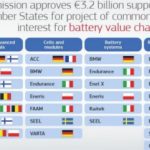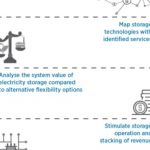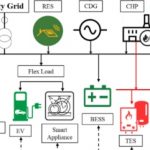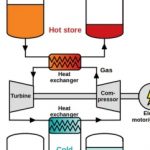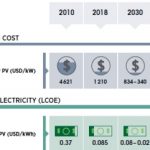Wayne Hicks at NREL describes research that’s created a virtual blockchain “prosumer” accounting system that replicates a live utility-scale grid. The goal of a real-world application is to allow countless individual households with their own electricity storage and generation to buy and sell power to each other; a truly revolutionary pathway. Clearly, it will require a system that securely accounts for vast amounts of transactions - a big enough … [Read more...]
Grid-scale Solar PV storage can use re-purposed old EV batteries
Once an EV battery has declined to 80% of its original capacity it is considered too weak for continued vehicle use. Recycling the battery – at that point - to make another one is expensive. MIT’s David Chandler describes how researchers there have run experiments and models to show that old EV batteries can instead be packed together and used as backup storage for grid-scale solar PV installations. It’s cheaper than building new Li-ion battery … [Read more...]
Negative electricity prices: lockdown’s demand slump exposes inflexibility of German power
The lockdown has unexpectedly allowed us to model certain aspects of the energy sector’s possible future. One is the oversupply of variable renewables into the grid. In Germany, a slump in demand plus an exceptionally sunny and windy few months sent wholesale electricity prices negative and to record lows. Fossil generators calculated that paying buyers to take electricity was cheaper than performing a shut-down re-start sequence, so they did … [Read more...]
U.S.: Counting Renewables jobs and projects under threat, what can be done and why
All sectors across all economies are trying to add up their potential job losses and projects in jeopardy, then telling their governments to prioritise them for Covid lockdown support. Mike Jacobs at the Union of Concerned Scientists looks at renewables in the U.S. He quotes news reports that over 100,000 workers in this fast-growing industry filed for unemployment in March 2020. On top of that, the already planned expiry and phase-down of … [Read more...]
Green Ammonia can replace fossil fuel storage at scale
What’s the best way to store energy, from industry scale to electric vehicles, replacing the widespread use of fossil fuels? Pure hydrogen is an energy dense alternative, but the gas takes up a lot of space. Liquid ammonia doesn’t, yet it contains the hydrogen and therefore the energy. Ian Wilkinson at Siemens explains the advantages of using ammonia, NH3. Already the world produces 180m tonnes a year, worth €80bn. It’s mainly for agricultural … [Read more...]
Europe needs its own EV battery recycling industry
Europe needs its own battery recycling industry, and the EU’s European Battery Alliance should make it happen, says Raphaël Danino-Perraud writing for the IFRI Centre for Energy & Climate. For economic, strategic and environmental reasons, today’s overwhelming dependence on outsourcing – in this case to Asia - for battery manufacture and recycling needs to change. To start with, Asia provides over 90% of global car battery output, half coming … [Read more...]
Grid Battery tech on track. It now needs re-designed markets, monetisation
The rapid expansion of variable renewable electricity generation is making cost effective storage more urgent. Sure enough, in Europe several electricity storage projects are under construction and new ones are announced almost on a weekly basis. The battery technology seems to be on track, with estimates of $156/kWh in 2019 dropping to $61/kWh by 2030. But progress is hampered by the lack of a market that recognises and rewards the true value of … [Read more...]
Multi-energy “island” Microgrids can increase grid resilience
As the number of different technologies producing power and providing storage increases, the grid is getting complicated. The best way to make it resilient against outages is therefore changing. The traditional way is to shut down the failing plant, leaving the rest of the grid to cope as best as it can with the change in voltage and frequency. Xi Zhang at the Energy Futures Lab, Imperial College, describes the research looking at multi-energy … [Read more...]
Don’t blame Wind, Solar for Coal cycling. It’s everyday variable demand
Joseph Daniel at the Union of Concerned Scientists explains why variable renewables like wind and solar are not forcing coal plants to cycle (ramp up and down). He presents data from the U.S. that clearly shows it’s straightforward variable demand that’s doing it, because demand has always varied considerably throughout the day. So stop blaming the arrival and growth of wind and solar for this “inefficiency”, he says. These renewables have plenty … [Read more...]
Pumped Thermal Electricity Storage: grid-scale, cheap materials, known tech, compact, install anywhere
We need to store the huge quantities of excess electricity generated by variable renewables. But what’s the best way? Currently, over 99% of large-scale electricity storage uses pumped hydro dams. But geography severely limits where you can build one. And the growth of grid-scale batteries is limited by raw material costs and short lifecycles. Antoine Koen and Pau Farres Antunez at Cambridge University review an important alternative, Pumped … [Read more...]
Pumped Storage Hydropower 2.0: steel dams, underground, or 1-10MW modular
Pumped Storage Hydropower (PSH) is one of the most cost-effective utility-scale options for grid energy storage. The U.S. has plants across the country, totalling over 20GW of capacity. Now the Dept of Energy (DoE) is backing four teams developing blue sky (water?!) ideas that should make the next generation of PSH even cheaper. In this article the National Renewable Energy Laboratory (NREL) tracks their progress so far. They include dams made of … [Read more...]
Machine learning cuts new EV battery design testing times by months, years
Normally, battery prototype testing can take months and years to find the optimal design for fast-charging and battery life. Now scientists from Stanford, MIT and the Toyota Research Institute have developed a machine learning programme that can cut battery testing times by 98%. They’ve applied it to EV batteries. The faster a new and improved design is proven and taken to market the more rapid the uptake of EVs we’ll have. Matthew Vollrath at … [Read more...]
Biofuels “light-to-power” slump: because photosynthesis is no match for Solar PV
The success of energy crops depends on many things. But the first link in the chain is a weak one: natural photosynthesis, the conversion of light into energy by plants. The problem is the efficiency of photosynthesis is no match for that of a modern solar PV cell. And while solar technology keeps improving, mother nature – not a signatory to the Paris Agreement – has no plans to do so. Any progress must come from biotechnology which is slow … [Read more...]
Lithium-Sulphur batteries: cheaper, greener, hold more energy
The rapid expansion of electric power across the world is putting a strain on battery production. The standard lithium-ion battery depends on minerals and metals in limited supply, so alternatives are needed urgently. Mahdokht Shaibani at Monash University describes the work of her team on developing lithium-sulphur batteries. There are many advantages, not least the abundance of sulphur, the 16th most common element on Earth. Added to that, … [Read more...]
Hydrogen’s future: reducing costs, finding markets
Although 100Mt/year of hydrogen is produced globally and at scale, it’s overwhelmingly for the chemical industry. So there’s a long way to go for it to play a role in the energy transition. It’s not even clear whether hydrogen will be best used directly as a power source or through further conversion into other powerfuels. That's why Dolf Gielen and Emanuele Taibi at IRENA are scoping out the challenges of reducing production costs and finding … [Read more...]
- « Previous Page
- 1
- …
- 7
- 8
- 9
- 10
- 11
- Next Page »







